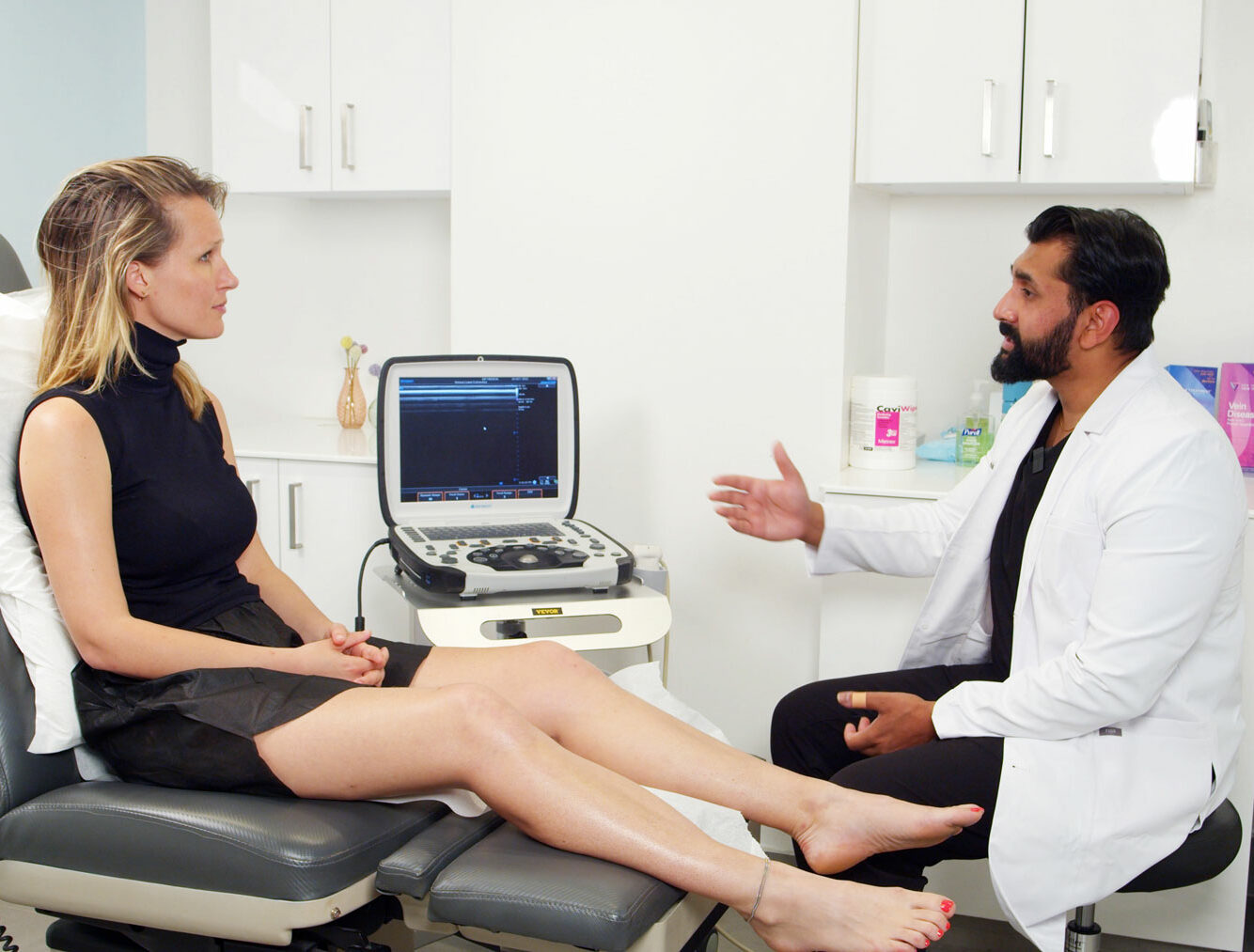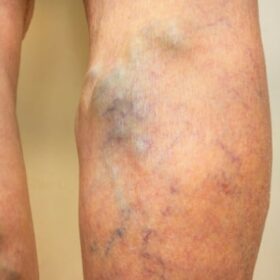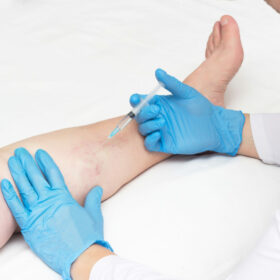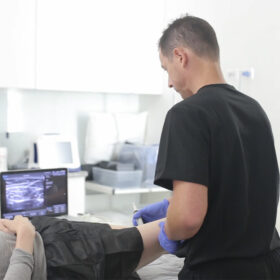If you’re dealing with varicose veins, you’re not alone. These swollen, twisted veins affect millions of people worldwide, and understanding what varicose veins are, their causes, symptoms, and available treatment options is essential. At Vein Treatment Clinic, our board-certified vein doctors specialize in providing minimally invasive treatments for varicose veins and spider veins. In this comprehensive guide, we’ll walk you through everything you need to know about varicose veins, from risk factors to prevention and treatment options.
What Are Varicose Veins?
Varicose veins are a prevalent vascular condition characterized by the abnormal enlargement and twisting of veins, typically found in the legs. These veins appear as bulging, blue or purple cords under the skin’s surface, often creating a cosmetic concern for many individuals. But what’s happening beneath the surface is more than just a cosmetic issue; it’s a result of underlying chronic venous insufficiency.
Varicose veins develop when the valves within the veins, responsible for directing blood flow towards the heart, become weakened or damaged. This dysfunction causes blood to flow backward and pool within the veins, resulting in their enlargement and distortion. While varicose veins are commonly associated with aesthetics, they can also lead to discomfort, pain, and more severe complications if left untreated.
Chronic Venous Insufficiency: The Root Cause
At the core of varicose vein development lies a condition known as chronic venous insufficiency (CVI). CVI is the underlying factor responsible for the formation of varicose veins and other vein problems, including spider veins.
In a healthy circulatory system, veins are equipped with one-way valves that facilitate the unidirectional flow of blood from the extremities back to the heart. However, in cases of CVI, these valves deteriorate or become dysfunctional. This impairment prevents the efficient return of blood, causing it to accumulate and pool within the affected veins, especially in the lower limbs. The increased pressure and congestion within these veins ultimately lead to their enlargement, distortion, and the visible manifestation of varicose veins.
Why Varicose Veins Primarily Affect the Legs
Varicose veins primarily affect the legs due to the significant challenges posed by gravity. Unlike arteries, veins have the task of carrying blood against gravity back to the heart. The legs, being the farthest extremities from the heart, face the greatest struggle. When the one-way valves within leg veins weaken or malfunction, gravity forces blood to flow backward and pool in the leg veins, causing them to enlarge and become varicose. This is exacerbated by prolonged periods of standing or sitting, which further hinder efficient blood circulation in the lower limbs.
Varicose Veins vs. Spider Veins
Varicose veins and spider veins are two distinct but related vascular conditions that often coexist. While they share similarities in appearance, they have different characteristics.
Varicose Veins
Varicose veins are larger, swollen, and typically blue or purple in color. They often appear as twisted cords or bulging veins on the skin’s surface, primarily in the legs. The primary cause of varicose veins is venous insufficiency, where weakened or damaged valves in deeper veins allow blood to flow backward and pool in the affected veins. Symptoms of varicose veins can include pain, aching, heaviness, and discomfort in the legs.
Spider Veins
Spider veins, on the other hand, are smaller, finer veins that often appear as red or blue lines or web-like patterns on the skin. They are usually closer to the skin’s surface and are commonly found on the face and legs. Spider veins are primarily caused by the dilation of tiny blood vessels due to various factors, including genetics, hormonal changes, and sun exposure. While spider veins are typically harmless, they can often be symptomatic of underlying chronic venous insufficiency. As such, an evaluation is necessary.
Risk Factors for CVI & Varicose Veins:
- Age: As individuals get older, the risk of both CVI and varicose veins increases due to the natural wear and tear on vein walls and valves.
- Gender: Women are more prone to both conditions, often attributed to hormonal fluctuations during pregnancy and menopause.
- Genetics: A family history of CVI or varicose veins can significantly raise the risk for developing these conditions.
- Obesity: Excess body weight places added pressure on veins, contributing to venous insufficiency and varicose vein formation.
- Prolonged Standing or Sitting: Occupations or activities that involve extended periods of standing or sitting can impair healthy blood circulation and exacerbate vein problems.
- Pregnancy: The increased blood volume and pressure on pelvic and leg veins during pregnancy elevate the likelihood of varicose veins.
- Hormonal Changes: Birth control pills and hormone therapy may influence vein health.
- Lack of Physical Activity: A sedentary lifestyle can weaken leg muscles and hinder blood circulation, making vein issues more likely.
- Smoking: Smoking negatively affects blood flow and increases the risk of CVI and varicose veins.
- Previous Deep Vein Thrombosis (DVT): A history of DVT can damage veins and valves, increasing the susceptibility to venous disorders.
- Injury or Trauma: Previous injuries to veins or legs can lead to weakened veins and a higher risk of venous insufficiency.
Signs & Symptoms of Varicose Veins:
- Visible Bulging Veins: Prominent, twisted, and swollen veins that are visible just beneath the skin’s surface, often in a blue or purple hue.
- Aching or Heaviness: A persistent, dull ache or feeling of heaviness in the legs, particularly after long periods of standing or sitting.
- Swelling: Swollen ankles and feet, particularly at the end of the day.
- Itching and Burning: An uncomfortable itching or burning sensation over the affected veins.
- Cramps: Muscle cramps, particularly at night, in the legs.
- Skin Changes: Skin near the varicose veins may become discolored, dry, or inflamed.
- Restless Legs: A restless or uncomfortable feeling in the legs, often experienced when trying to sleep.
- Ulcers: In severe cases, varicose veins may lead to the development of venous ulcers, particularly around the ankles.
- Bleeding: Rarely, varicose veins may bleed if the skin covering them becomes thin and damaged.
Potential Long-Term Complications of Varicose Veins:
- Skin Changes: Over time, varicose veins can lead to skin discoloration and inflammation near the affected veins.
- Venous Ulcers: In severe cases, persistent venous insufficiency can cause open sores or ulcers on the skin, typically around the ankles.
- Bleeding: Thin and fragile skin over varicose veins may lead to occasional bleeding.
- Superficial Thrombophlebitis: Blood clots can form in varicose veins, resulting in inflammation and pain in the affected area.
- Deep Vein Thrombosis (DVT): In rare instances, complications from varicose veins can contribute to the development of DVT, a potentially life-threatening condition.
- Reduced Quality of Life: The physical and psychological effects of varicose veins can impact one’s quality of life, causing pain, discomfort, and self-esteem issues.
How Are Varicose Veins Diagnosed?
Diagnosing varicose veins accurately is a crucial step in determining the most appropriate treatment plan. To achieve this, vein doctors use a method known as duplex ultrasound.
Duplex ultrasound is a non-invasive imaging technique that combines two types of ultrasound – Doppler ultrasound and B-mode ultrasound. Doppler ultrasound measures the speed and direction of blood flow within the veins, while B-mode ultrasound creates a visual representation of the veins’ structure. By integrating these two modes, vein doctors obtain a comprehensive view of the veins, allowing them to identify the presence of varicose veins, assess the severity of venous insufficiency, and pinpoint the precise location of any valve dysfunction or blockages.
Your Duplex Ultrasound Examination
During a duplex ultrasound examination, a gel is applied to the skin overlying the veins of interest, and a handheld transducer is used to emit and receive ultrasound waves. These waves bounce off blood cells and tissues, creating detailed images of the veins on a monitor. By analyzing these images and the Doppler readings, vein doctors can determine the extent of venous insufficiency, plan appropriate treatments, and monitor progress over time.
Benefits of Duplex Ultrasound Tests:
- Non-invasive
- Highly accurate
- Visualizes vein structure
- Assesses blood flow
- Identifies varicose veins
- Determines venous insufficiency severity
- Pinpoints valve dysfunction or blockages
- Guides treatment planning
- Monitors treatment progress
Minimally Invasive Treatments for Varicose Veins
At Vein Treatment Clinic, we specialize in minimally invasive treatments for varicose veins and spider veins. These treatments are highly effective and offer the advantage of quicker recovery times and minimal discomfort. Some of our most commonly used treatments include:
- Sclerotherapy: Sclerotherapy is a non-surgical procedure that involves injecting a solution directly into the affected vein. This solution irritates the vein’s lining, causing it to collapse and eventually fade away. Sclerotherapy is particularly effective for smaller varicose veins and spider veins.
- Endovenous Laser Ablation (EVLA): EVLA is a minimally invasive procedure that uses laser energy to seal off the damaged vein. This forces the blood to reroute through healthier veins, reducing the appearance of varicose veins. EVLA is highly effective.
- Radiofrequency Ablation (RFA): RFA is similar to EVLA but uses radiofrequency energy to close off the damaged vein. It’s a safe and efficient treatment option for varicose veins.
- VenaSeal Closure System: The VenaSeal Closure System is a cutting-edge treatment that uses a medical adhesive to seal the diseased vein shut. This procedure is virtually painless and requires no post-treatment compression stockings.
- ClariVein: ClariVein is a combination of mechanical and chemical vein closure. It involves a small catheter with a rotating tip that delivers a sclerosing agent to close the vein while mechanically disrupting its lining.
- Ambulatory Phlebectomy: Ambulatory phlebectomy is a surgical procedure used for removing larger varicose veins through small incisions. It is performed on an outpatient basis, and patients typically experience minimal discomfort and a quick recovery.
The Importance of Choosing a Vein Specialist
When seeking treatment for varicose veins, it’s crucial to consult with a board-certified vein doctor who specializes in venous conditions. At Vein Treatment Clinic, our vein specialists have the knowledge and expertise to provide you with the best care and treatment options.
At Vein Treatment Clinic, we are dedicated to providing the highest level of care for individuals dealing with varicose veins. Our state-of-the-art locations across the United States, including New York, New Jersey, Long Island, California, and Washington DC, are staffed by experienced board-certified vein doctors committed to helping you achieve healthy, beautiful legs. Don’t let varicose veins hold you back; schedule your consultation with us today.












